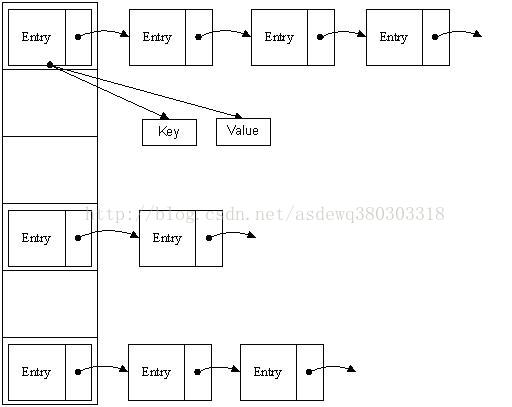面试题: Java中ArrayList和LinkedList的主要区别是什么?
这个问题首先要知道数组和链表的特点
?
数组的特点:寻址容易,插入和删除困难。
链表的特点是:寻址困难,插入和删除容易。
ArrayList的底层实现就是通过动态数组来实现的,LinkedLIst底层实现就是通过链表来实现的,所以直接答出数组和链表的特点就ok
面试题:hashMap是怎样实现key-value这样键值对的保存?
HashMap中有一个内部类Entry,
?
class="html"> static class Entry<K,V> implements Map.Entry<K,V> {
final K key;
V value;
Entry<K,V> next;
int hash;
//.....
}
主要有4个属性,key ,hash,value,指向下一个节点的引用next ,看到这个实体类就明白了,在HashMap中存放的key-value实质是通过实体类Entry来保存的
?
面试题:hashMap的实现原理?
HashMap使用到的数据类型主要就是数组和链表,首先看原理图

在hashMap的原理图中,左边是通过数组来存放链表的第一个节点,看懂这个图这个问题就ok
面试题:hashMap的put过程?
面我们提到过Entry类里面有一个next属性,作用是指向下一个Entry。比如说: 第一个键值对A进来,通过计算其key的hash得到的index=0,记做:Entry[0] = A。一会后又进来一个键值对B,通过计算其index也等于0,现在怎么办?HashMap会这样做:B.next = A,Entry[0] = B,如果又进来C,index也等于0,那么C.next = B,Entry[0] = C;这样我们发现index=0的地方其实存取了A,B,C三个键值对,他们通过next这个属性链接在一起。也就是说数组中存储的是最后插入的元素。
?
public V put(K key, V value) {
if (key == null)
return putForNullKey(value);
int hash = hash(key);
int i = indexFor(hash, table.length);
for (Entry<K,V> e = table[i]; e != null; e = e.next) {//循环判断插入的key是否已经存在,若存在就更新key对应的value
Object k;
if (e.hash == hash && ((k = e.key) == key || key.equals(k))) {
V oldValue = e.value;
e.value = value;
e.recordAccess(this);
return oldValue;
}
}
modCount++;
addEntry(hash, key, value, i);//key不存在,那么插入新的key-value
return null;
}
void addEntry(int hash, K key, V value, int bucketIndex) {
if ((size >= threshold) && (null != table[bucketIndex])) {
resize(2 * table.length);
hash = (null != key) ? hash(key) : 0;
bucketIndex = indexFor(hash, table.length);
}
createEntry(hash, key, value, bucketIndex);
}
void createEntry(int hash, K key, V value, int bucketIndex) {//这个方法就验证了上面说的数组中存储的是最后插入的元素
Entry<K,V> e = table[bucketIndex];
table[bucketIndex] = new Entry<>(hash, key, value, e);
size++;
}
面试题:hashMap的get过程?
这个过程比较简单,直接看代码:
public V get(Object key) {
if (key == null)
return getForNullKey();
int hash = hash(key.hashCode());
//先定位到数组元素,再遍历该元素处的链表
for (Entry<K,V> e = table[indexFor(hash, table.length)];
e != null;
e = e.next) {
Object k;
if (e.hash == hash && ((k = e.key) == key || key.equals(k)))
return e.value;
}
return null;
}
面试题:hashMap存取的时候是如何定位数组下标的?
找到indexFor这个方法,hashMap就是通过这个方法获取数组下标的:
?
?
static int indexFor(int h, int length) {
return h & (length-1);
}
通过key的hash值和数组长度求&,这意味着数组下标相同,并不表示hashCode相同。所以在Entry中存有一个hash值,在比较Entry的时候都是想比较hash值
面试题:hashMap中数组的初始化大小过程?
?
找到hashMap的构造方法:
?
public HashMap(int initialCapacity, float loadFactor) {
.....// Find a power of 2 >= initialCapacity
int capacity = 1;
while (capacity < initialCapacity)
capacity <<= 1; //相当于capacity = capacity * 2
this.loadFactor = loadFactor;
threshold = (int)(capacity * loadFactor);
table = new Entry[capacity];
init();
}
从上面的代码我们可以看出数组的初始大小并不是构造函数中的initialCapacity!!而是2的n次方
面试题:hashMap什么时候开始rehash?
在hashMap中有一个加载因子loadFactor,默认值是0.75,当数组的实际存入值的大小 > 数组的长度×loadFactor 时候就会rehash,重新创建一个新的表,将原表的映射到新表中,这个过程很费时。
?
?